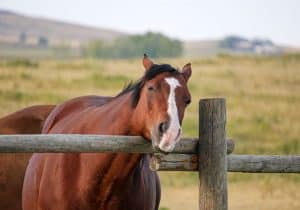Understanding Sudden Death in Horses

Sudden death in horses is the unexpected demise of a healthy athlete during exercise or within 60 minutes of completing it. The problem is one of great concern to the equine industry; the condition has the potential to cause human injury in addition to the loss of a valued equine partner. In a small retrospective survey sudden death was most common in event horses.
Causes of Sudden Death
Sudden death does not include loss of the equine athlete from catastrophic musculoskeletal injures. Reported causes of sudden death include respiratory failure, severe exercise-induced pulmonary hemorrhage (EIPH), and spinal cord injury. Aortic rupture or rupture of another large artery—usually easily identifiable on postmortem examination—can also lead to sudden cardiac death (SCD). When veterinary pathologists find no evidence of respiratory or cardiac failure or vessel rupture in a case of sudden death, they often attribute the cause to SCD due to a fatal cardiac arrhythmia—an irregular or abnormal rhythm.
On histopathological, or microscopic, examination of horses that have succumbed to sudden cardiac death, veterinarians might detect pale or white areas in the myocardium (heart muscle) or myocardial necrosis (tissue death), inflammation, or fibrosis (scarring), although they often find no abnormalities. Further complicating the interpretation of histopathological findings, these lesions can appear in horses that are euthanized or die of other causes. If pathologists do not find lesions on postmortem exam, which is not uncommon in young racehorses, they frequently implicate fatal cardiac arrhythmia as the cause.
We know that most arrhythmias causing death in the immediate post-exercise period affect the lower (ventricular) chambers of the heart. Identifying the rhythm disturbance is the first step in successfully treating the arrhythmia if it is life-threatening.
Sudden Cardiac Death in Humans
Numerous studies in human athletes have described sudden cardiac death incidence, which appears to be much lower than what is occurring in equine athletes. Physicians rely on prompt administration of CPR and defibrillation to successfully resuscitate affected human athletes—scenarios that are not effective in adult horses (you can only perform CPR successfully on foals). Most human athletes affected by sudden cardiac death have underlying structural heart disease, usually from abnormalities that do not affect the horse, such as coronary artery disease. Therefore, in our quest to better understand SCD in horses, humans might not be the best model.
Cardiac Arrhythmias During Exercise
Research is ongoing worldwide to understand what is normal in the exercising horse and to identify preexisting problems whenever possible. In a recent research review, Cris Navas de Solis, LV, MS, PhD, discussed arrhythmias’ potential clinical relevance in sudden cardiac death cases. Other researchers who have studied arrhythmias in normally performing horses have found most arrhythmias occur immediately after exercise.
Physick-Sheard et al. reported that Standardbreds can experience arrhythmias while racing, but most occur in the immediate post-exercise period when a scenario called punctuated deceleration—sudden cardiac slowing— occurs. Post-exercise arrhythmias are more common in horses exercising at higher heart rates (> 199 beats per minute). Slack et al. determined that Standardbreds’ maximal heart rate when performing an exercise stress test on the treadmill was an excellent predictor of complex cardiac arrhythmias (i.e., life-threatening ventricular arrhythmias) during recovery. Similarly, Durando et al. reported that the longer eventers exercised on cross-country with heart rates over 199 bpm, the more likely they were to have complex arrhythmias.
While these studies and others clarify what rhythm disturbances occur in normally performing horses, we need to further investigate the relationship between arrhythmias, poor performance, and SCD; it’s the only way to find the balance between what’s normal in competition and what places horse and rider at risk.
Cardiac Rhythm Monitoring
In the meantime, studies using wearable electrocardiogram recording devices are providing us more information about the equine athlete’s heart rhythm during exercise or immediately after. Also, as more riders and trainers begin using the inexpensive, readily available handheld recording electrodes that pair with a smartphone, we’ll be able to gather more data on post-exercising arrhythmias in distressed or collapsing horses. Owners and veterinarians can forward these recordings to internists specializing in equine cardiology for interpretation.
Written by:
Virginia B. Reef, DVM, Dipl. ACVIM, ACVSMR, Assoc ACVDI
Related Articles
Stay on top of the most recent Horse Health news with















